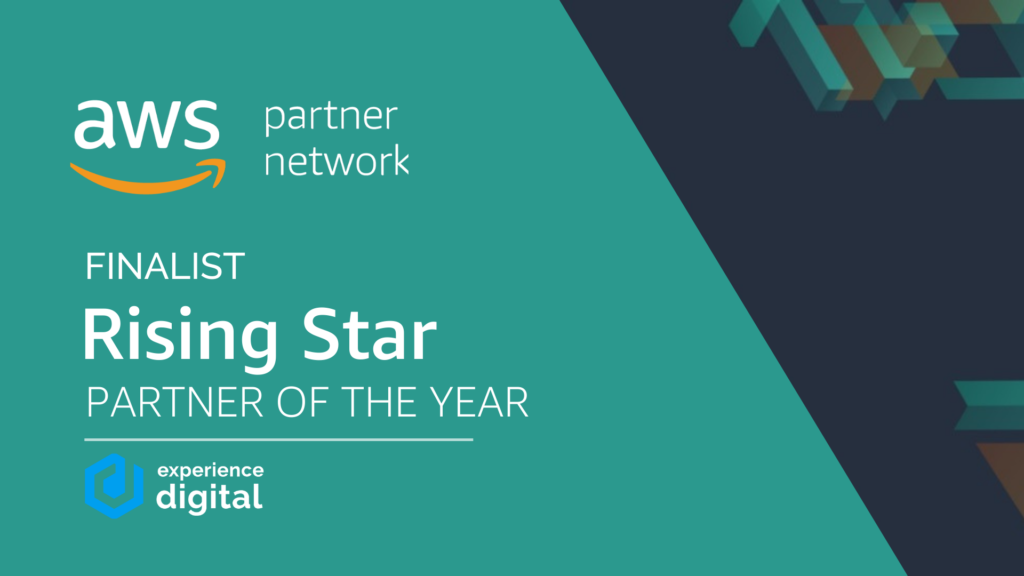Our Co-Founder Dave, and subsequently our whole team here at Experience Digital, are extremely passionate about transparency when it comes to working with our customers. Abiding by a customer-first mindset, similarly to AWS, this mentality comes as second nature to us. It goes hand in hand with fuelling our array of longstanding customer relationships.
Building or migrating to cloud architecture is extremely complex, therefore it’s a necessity to ensure that applications are built to the highest level of standards – for resilience, scalability and profitability. Being transparent about project timeframes and potential roadblocks is core to how we operate to build rapport and a strong reputation.
Our approach to projects is similar to that of a mentor to our customers – we want them to succeed. We do this by providing them with the tools, resources and support required to streamline the entirety of their cloud journey.
And, that’s where AWS comes into it.
They say there’s no point ‘reinventing the wheel’, so why not leverage one of the largest and most reputable global cloud providers to further our capability and help our customers succeed? It’s a win-win!
Getting Well-Architected with AWS
As an AWS Advanced Consulting Partner, here at Experience Digital, we’ve been leveraging AWS services for almost a decade, with the Well-Architected Framework consistently governing how we operate in the cloud. The overarching concept is simple, as coined by AWS themselves, existing to ‘help you understand the decisions you make whilst building workloads on AWS’.
So what exactly does it encompass? Let’s break it down.
The Well-Architected Framework was introduced in 2012 as a set of guidelines built in response to customer feedback. Their goal was to build a place where best practices and guiding principles could be widely accessed, and written in a manner that is much broader than a simple checklist. It has since evolved to encompass countless resources as well as a purpose-built Well-Architected tool to assist developers in building workloads to the highest levels of resilience.
The Framework promotes the idea of constant improvement. Evaluating design, architecture, and implementation all represent the overarching progress toward their desired outcome. The necessity to practice informed decision making, prioritise risk mitigation and utilise best practices is of utmost importance.
Therefore, the Framework now operates as a primary mechanism that continues to be built upon to provide insight and expertise in best practice. AWS also provides industry-specific lenses such as Machine Learning, IoT and SaaS to personalise the framework in specific use cases.
Why is this so important?
Utilising best practices is often largely underrated.
But why?
Due to the nature of looming project deadlines, shorter timeframes, budget pressures, demanding customers or simply having a lack of qualified talent to assist – attention to detail can tend to slip through the cracks.
Secondly, let me paint a picture.
AWS offers over 200+ products and services (and growing), which all require constant iterations to ensure their reliability and security, meaning software updates. Although always updating software seems like the most simple way to mitigate vulnerabilities in the cloud, software updates are often missed or ignored. This consistent necessity opens up a world of possibility in the realm of cyber risk.
The Pillars of the AWS Well-Architected Framework
The pillars operate as the cornerstone of any AWS Architecture, as outlined below.
Operational Excellence is the ability to understand how customers use their workloads and where systems or procedures could be improved to maximise delivering business value. This primarily focuses on running and monitoring systems with topics ranging from automation, event responses and defining stands to manage day-to-day operations.
Security is a no-brainer. This pillar focuses on maintaining the integrity and confidentiality of data, controlling access management to protect systems and establishing controls to detect security vulnerabilities
Reliability promotes the notion of a workload performing for its intended function consistently. The ability to recover from a failure or outage to meet growing business and customer demands. A key theme in this realm is that of change management as well as preventative system design.
Performance Efficiency acts to ensure the correct compute resources are chosen in alignment with your requirements and utilised efficiently to minimise cost, risk and maximise reliability. This extends to then monitoring performance and making informed decisions to maintain efficiency as business needs evolve.
Cost Optimisation focuses on avoiding unnecessary costs. This involves understanding your expenditure and selecting the most aligned resources to your requirements. Constant analysing over time promotes scalability without overspending.
Furthermore, as mentioned above, industry-specific lenses were also introduced last year. Including the addition of the Serverless lense, further diversifying AWS’ ability to provide workload-specific advice.
Give Me (Back) The Money
So let’s delve into the good stuff, what we’re all here for – how can you optimise costs by utilising this Framework?
The Cost Optimisation Pillar opens up a whole world of resources and guidelines to ensure you’re managing your spending whilst not having to compromise on quality. Cost Optimisation specifically feeds into the overarching concept of perpetual improvement, defining this process as a continuous refinement over the lifecycle of your workload.
To summarise the design principles that guide Cost Optimisation by AWS, they are:
Implement Cloud Financial Management: To put it simply, dedicate adequate time and resources to build knowledge and capability, allowing you to build processes, similarly to in any other department of your business.
Adopt a Consumption Model: Pay only for the compute resources you’re using as demand fluctuates (this can save you up to 75%!).
Measure Overall Efficiency: Analyse the output and cost of your workload associated with delivery. You can then use this data to understand and influence future business decisions, such as increasing functionality or reducing cost.
Analyse and Attribute Expenditure: Similarly to other facets of your life, this involves itemised budgeting. Thankfully, the cloud makes it easier to identify this data allowing for transparent cost attribution against revenue streams, accurately measuring your ROI.
Stop Spending Money on Undifferentiated Heavy Lifting: Outsource the hard work of administration, management or forecasting, where you can. This allows you to focus on your customers and business, rather than the infrastructure.
Further to this, the key recommendations from AWS to reduce costs involve:
- Practising Cloud Financial Management
- Expenditure and usage awareness
- Cost-effective resources
- Managing demand and supplying resources
- Optimising over time
Let Us Do the Heavy Lifting
As recommended by AWS, it’s important to outsource or automate processes where possible to increase business agility and maximise optimisation. If this all sounded a bit too complex, let us do the heavy lifting.
Here at Experience Digital, we pride ourselves on our ability to budget, keeping our customer’s costs low to increase their chances at long-term scalability and success. Book in your Well-Architected Review and our team of experienced engineers will audit your architecture and provide a comprehensive report with actionable items and recommendations on the next steps.
The benefits of booking your Well-Architected Review with us include:
- Receive a comprehensive audit of your AWS account with the knowledge & skills on how to consistently improve your business operations
- Access in-depth guidance and valuable cost optimisation techniques for building capability within the design of your workload, selection of services, configuration and operation
- Grow your understanding of cybersecurity, reliability and performance efficiency to influence future business decisions
- Unlock the endless potential to reduce your AWS spending and build a highly resilient and scalable cloud workload
- Utilise countless robust cloud service resources, trusting in AWS’ global reputation
- Access up to $5,000 worth of AWS credits*
*Pending Experience Digital complete Well-Architected Review & 25% of HRIs per workload are resolved






